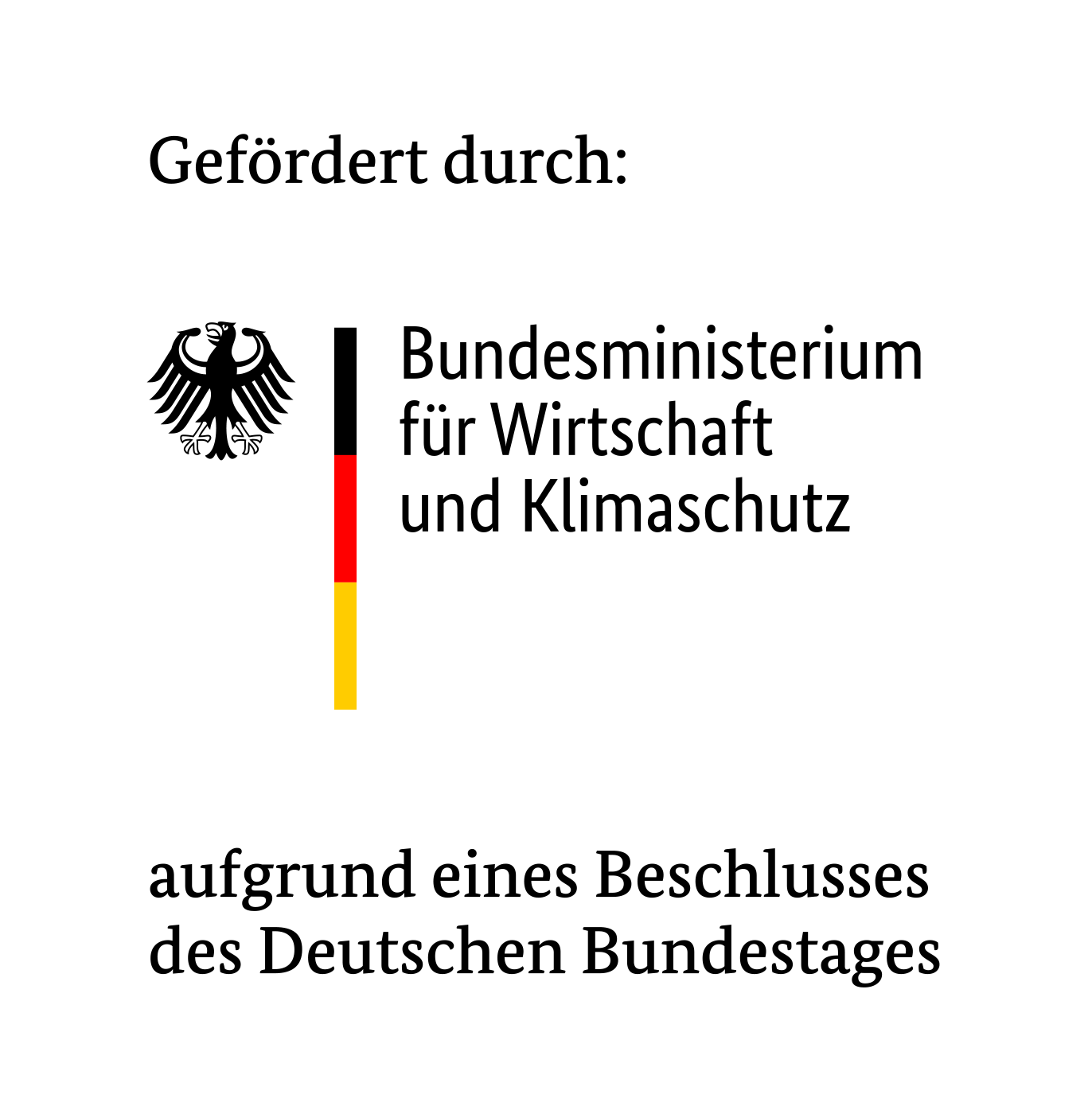FAQ: Note
Here you will find guidance on the emission reduction measures available in the Pathways to Paris transformation tool. This information relates e.g. to the limited availability of some measures, or negative effects in terms of ecological sustainability in the event of excessive scaling. The information is structured according to the ten sectors in the tool and should be considered when planning measures.
“Scenario” or “reference scenario” always means the scenario underlying the basic assumptions of the project: “Climate-neutral Germany 2045: How Germany can achieve its climate goals before 2050”. This scenario was published in 2021 by the Prognos Institute, the Öko-Institut and the Wuppertal Institute.
Ammonia
Carbon Capture and Storage (CCS)
Ammonia, as a significant point source of emissions, offers great potential for savings through CCS. However, CCS should only be seen as an interim solution until sufficient green hydrogen is available to convert the production facilities, as green hydrogen represents the long-term solution for effective and sustainable emission reduction.
New automobile registrations
Key Technology: Battery Electric Vehicles (BEV)
Due to their market maturity, the rapid conversion to e-mobility is critical to the success of the transformation. From 2032, BEVs will account for more than 99% of new vehicle registrations. However, economies of scale must be taken into account: The reference scenario assumes a 34% decline in the number of vehicles between 2020 and 2050, due to a change in mobility behavior. If BEVs are scaled beyond that, their electricity demand could exceed the supply from renewable energies and thus compete with the electricity demand of other sectors and/or act as an emissions driver.
Plug-in hybrids
Plug-in hybrids play a very minor role in the reference scenario. Accordingly, they can only be used to a limited extent and as a transitional technology. In the reference scenario, their use will already peak in 2030, with a 26% share of new vehicle registrations.
Fuel cell vehicles
Fuel cell vehicles play practically no role in the reference scenario, since their main energy carrier, hydrogen, is needed more in other sectors and can be used more efficiently. In the reference scenario, they will already reach their peak in 2020 with 2% of new registrations.
Commercial real estate/residential real estate
Key technologies: heat pumps and district heating
In the reference scenario, heat pumps and district heating represent the key technologies for the decarbonization of commercial and residential real estate. In 2030, heat pumps will heat 24% of living space and 15% of commercial space. In 2040, these shares will rise to 47% and 24%, and in 2050 to 60% and 30%. In 2030, district heating accounts for 16% of living space and 14% of commercial space. In 2040, 22% of living space and 26% of commercial space will be heated with district heating, and in 2050 26% and 33%.
Heat pumps
Heat pumps must be operated with electricity from renewable energies in order to achieve the necessary reduction effect assumed in the tool. In addition, it should be considered that the heating requirement of a building should be particularly low for the installation of a heat pump. In existing buildings, the installation of a heat pump is therefore usually linked to the energy-related refurbishment. Structural restrictions (e.g. monument protection, lack of skilled workers) can make the installation of a heat pump difficult or even impossible.
District heating
For district heating, the tool uses the decarbonization rate that the reference scenario estimates for the electricity sector. District heating is developing based on its current average emission intensity. The reduction effect specified in the tool is only achieved if the district heating network used meets these assumptions. In addition, the feasibility must be checked on a site-specific basis, since (district) heating networks are natural monopolies and their expansion depends on the regulatory framework.
Hydrogen
Hydrogen is only available to a very limited extent and other solutions exist in the building sector. Therefore, hydrogen should first be used for other (industrial) purposes where less low-emission alternatives exist. In the reference scenario, hydrogen therefore plays practically no role in building heating.
Energy renovation
As envisaged in the reference scenario, the average energy demand of buildings must fall before an efficient conversion of energy sources can take place. Energetic refurbishment is therefore often a condition for switching to alternative energy sources, which is reflected in the tool. At the same time, energy-related refurbishments can be delayed by various factors, including a lack of skilled workers, material shortages or structural restrictions.
consideration of the upstream chain
The tool only takes into account the emissions that arise from the use of heating energy sources. When selecting a heating technology, the upstream chain should also be taken into account.
Platform chemicals
Pyrolysis (Chemical Recycling)
Chemical recycling is acceptable as a niche solution. It is still under development. Questions of energy, environmental and pollutant balance still need to be clarified in this context.
Steel
Carbon Capture and Storage (CCS)
Only CCS is anchored in the reference scenario as a solution technology. Carbon capture and usage is explicitly not intended, as CO2 captured in this way is delayed but still enters the atmosphere. CCS is not yet legally permitted in Germany. If CCS is permitted, then the energy-intensive capture and compression plants must be powered by renewable energy. The captured CO2 must not escape when it is stored. The infrastructure required for CO2 transport still has to be created. It is not yet clear which industrial regions will be connected and when. In general, the life cycle of the end product must be considered with CCS.
Biocarbon
For the production of the required biochar, no green areas with a high level of biodiversity, forest areas or peat bogs may be used for cultivation. This ensures an almost CO2-neutral production of the biochar and averts negative economies of scale. The possibility of these negative economies of scale stems from the fact that biochar (like biogas) is seen as a decarbonisation opportunity in many sectors, but sustainable biochar is not sufficient to supply all interested sectors. Biomass should be used based on the use of residues according to the cascade principle, i.e. primarily as food and in material use. Energetic use should primarily take place in industrial heat use and must not be at the expense of the sink function of the forest.
Hydrogen
When using hydrogen, green hydrogen must be used to ensure sustainability and the required GHG reduction rates.
Road freight transport
Hydrogen
Hydrogen drives are only used to a limited extent in the reference scenario; In order to keep the overall energy requirement as low as possible, the dominant transformation technology is the electric motor. According to the scenario, hydrogen drives will reach their maximum share of the drive mix in 2045 at 24%. They are primarily used in heavy-duty long-distance traffic. In order for the hydrogen used to reduce emissions, only energy from renewable sources may be used in its production.
Synthetic fuels
Due to their high costs and very limited availability, synthetic fuels are mainly used in air and sea transport and play a very limited role in road freight transport – their maximum of 3% is reached in the 2040 scenario. The energy required for their production comes solely from renewable energy sources, the required CO2 from direct air capture.
Second and third generation biofuels
Biofuels are only obtained from waste and residues (slurry, hydrogenated vegetable oil) and are subject to temporary use restrictions until 2030 as a bridging solution. They are only produced using renewable energy.
Electricity-based drive systems
The electricity for electricity-based drive systems must be provided solely from renewable energies in order to ensure the emission reductions estimated in the tool.
Electricity
Key technologies: solar energy and wind energy
Solar and wind energy represent the key technologies for reducing emissions: after their combined share in net electricity generation from renewable energies reaches 87% in 2030, it will increase to 97% by 2050.
Carbon Capture and Storage (CCS)
Only CCS is anchored in the reference scenario as a solution technology. Carbon capture and usage is explicitly not intended, as CO2 captured in this way is delayed but still enters the atmosphere. CCS is currently not permitted by law in Germany. If CCS were to be approved, the energy-intensive capture and compression plants would need to be powered by renewable energy. The captured CO2 must not escape when it is stored. The infrastructure required for CO2 transport would have to be created. It is not yet clear which industrial regions will be connected and when.
Bioenergy
The additional firing of coal-fired power plants must take place exclusively using biomass. For the production of the required biomass, no green areas with a high level of biodiversity, forest areas or peat bogs may be used for cultivation. Otherwise, negative economies of scale can occur, since biogas and biomass (such as biochar) are seen as a possibility for decarbonization in many sectors, but both are not sufficient to supply all interested sectors. Biomass should be used based on the use of residues according to the cascade principle, i.e. primarily as food and in material use. Energetic use should primarily take place in industrial heat use and must not be at the expense of the sink function of the forest. Overall, bioenergy can be seen as a niche solution: In the reference scenario, its use falls in absolute terms from 38 TWh net electricity generation in 2030 to 10 TWh in 2050. The latter corresponds to 1% of renewable energy production in 2050.
Cement
Carbon Capture and Storage (CCS)
Only CCS is anchored in the reference scenario as a solution technology. Carbon capture and usage is explicitly not intended, as CO2 captured in this way is delayed but still enters the atmosphere. CCS is not yet legally permitted in Germany. If CCS is permitted, then the energy-intensive capture and compression plants must be powered by renewable energy. The captured CO2 must not escape when it is stored. The infrastructure required for CO2 transport still has to be created. It is not yet clear which industrial regions will be connected and when. In general, the life cycle of the end product must be considered with CCS.
Biogas
For the production of the required biomass, no green areas with a high level of biodiversity, forest areas or peat bogs may be used for cultivation. This ensures an almost CO2-neutral production of the biogas and averts negative economies of scale. The possibility of these negative economies of scale stems from the fact that biogas (like biochar) is seen as an opportunity for decarbonisation in many sectors, but sustainable biogas is not sufficient to supply all interested sectors on a large scale. Biomass should be used based on the use of residues according to the cascade principle, i.e. primarily as food and in material use. Energetic use should primarily take place in industrial heat use and must not be at the expense of the sink function of the forest.
Power to Gas (PtG)
PtG energy sources used must be produced with green hydrogen in order to achieve the required (and assumed in the tool) GHG reduction.
Slag sands
The availability of blast furnace slag as a by-product of steel production is expected to decrease as production switches to alternative processes. In this case, local availability must be taken into account.
Contact
Pathways to Paris is a project funded by the Federal Environment Ministry (BMU). The project duration is expected to be two years.
WWF Germany and PwC Germany accompany and support the participating companies in the development of transformation paths that are necessary to achieve the goals of the Paris climate protection agreement. In addition to creating a common understanding and broad acceptance of the requirements of a successful climate change, sector-specific, reproducible transformation paths are highlighted, which are made publicly available.
Exclusive advice with a direct effect on e.g. production technologies, strategic planning or value chains of individual companies does not take place. Furthermore, there are no financial liabilities between the participating companies and the project initiators within the framework of the project, so that any conflicts of interest are excluded.
If you are interested, the first step is to clarify the role that you can play in the project. In doing so, we will take into account any independence restrictions that you may be subject to, particularly as an audit client of PwC.


